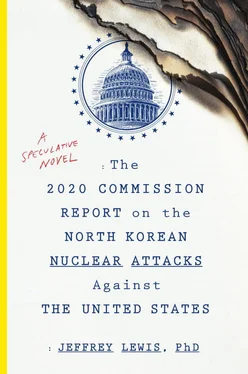Jeffrey Lewis - The 2020 Commission Report on the North Korean Nuclear Attacks Against the United States
Здесь есть возможность читать онлайн «Jeffrey Lewis - The 2020 Commission Report on the North Korean Nuclear Attacks Against the United States» весь текст электронной книги совершенно бесплатно (целиком полную версию без сокращений). В некоторых случаях можно слушать аудио, скачать через торрент в формате fb2 и присутствует краткое содержание. Город: New York, Год выпуска: 2018, ISBN: 2018, Издательство: Mariner Books, Жанр: Фантастика и фэнтези, Триллер, на английском языке. Описание произведения, (предисловие) а так же отзывы посетителей доступны на портале библиотеки ЛибКат.
- Название:The 2020 Commission Report on the North Korean Nuclear Attacks Against the United States
- Автор:
- Издательство:Mariner Books
- Жанр:
- Год:2018
- Город:New York
- ISBN:9-781-328-57391-9
- Рейтинг книги:4 / 5. Голосов: 1
-
Избранное:Добавить в избранное
- Отзывы:
-
Ваша оценка:
- 80
- 1
- 2
- 3
- 4
- 5
The 2020 Commission Report on the North Korean Nuclear Attacks Against the United States: краткое содержание, описание и аннотация
Предлагаем к чтению аннотацию, описание, краткое содержание или предисловие (зависит от того, что написал сам автор книги «The 2020 Commission Report on the North Korean Nuclear Attacks Against the United States»). Если вы не нашли необходимую информацию о книге — напишите в комментариях, мы постараемся отыскать её.
The 2020 Commission Report on the North Korean Nuclear Attacks Against the United States — читать онлайн бесплатно полную книгу (весь текст) целиком
Ниже представлен текст книги, разбитый по страницам. Система сохранения места последней прочитанной страницы, позволяет с удобством читать онлайн бесплатно книгу «The 2020 Commission Report on the North Korean Nuclear Attacks Against the United States», без необходимости каждый раз заново искать на чём Вы остановились. Поставьте закладку, и сможете в любой момент перейти на страницу, на которой закончили чтение.
Интервал:
Закладка:
“We were so worried that the Americans might try to stop us,” Im explained, “that it never occurred to us they might make things worse. I don’t even use Twitter.”
Launching a ballistic missile strike is not as easy as simply pressing a button.
Each missile is carried by a massive truck. Those trucks are parked within massive earthen bunkers with a curious shape. They are called “drive-through” bunkers because they have an entrance on one side and an exit on the other so that the massive vehicle can drive in one side and out the other without having to turn around.
The bunkers in South Korea had the same distinctive shape as the ones that the United States built in Europe during the Cold War. The American bunkers, abandoned at the end of the Cold War, now sit empty—although one of the locations was used as a set for a Star Wars movie. A space ship sat in the same spot once occupied by a ground-launched cruise missile armed with a 100-kiloton nuclear warhead.
The bunkers in South Korea, by contrast, were neither abandoned nor empty.
After the teleconference between President Moon and the Army Missile Command, Major General Lee placed two missile units on alert, one located near the South Korean city of Wonju, the other sitting on the far edge of Baengnyeong Island. Both units received the same order: to fire three ballistic missiles at targets in North Korea, for a total of six missiles. The crews waited through the day until the sun set—first over Wonju and then, nine minutes later, at 6:52 PM, over Baengnyeong Island.
The order, called a “fire mission assignment,” contained three kinds of information. It told the crew where to go (the “fire point”), specified when the unit should launch (the “method of control”), and then told the crew where to go after the launch.
The crews did not have to go far to reach their fire points. Major General Lee’s order specified that the trucks should park on a series of pre-surveyed concrete pads just outside the massive earthen bunkers and launch their missiles from there.
The orders also gave the missile crew instructions as to the method of control. A missile commander can give a crew the freedom to “fire when ready,” but in this case Major General Lee told both the crew and the commander to launch “at my command.” That would give him one last opportunity to call off the strike before the missiles were airborne.
Finally, Major General Lee ordered the units to move to new positions several miles from each base once they had completed their fire missions. While his surviving aides all testified that they did not expect North Korea to retaliate, this final precaution makes sense in light of the fact that North Korea almost certainly knew the location of many of South Korea’s missile bases; prudence dictated that the launch vehicles move to safety and reload. “If things did get out of control,” Lee’s deputy explained, “we wanted to be prepared.” Had Major General Lee not given this final order, it is unlikely that the commission would have had the opportunity to interview the launch crews.
One by one, each truck drove out into the night and parked on a concrete square. Each vehicle was aligned along a heading specified in the fire order, pointing toward Pyongyang or Chunghwa. Each crew parked its vehicle in the darkness, with no lights, set the brake, and then extended the hydraulic jacks that would lift the vehicle just off its tires and ensure that it was perfectly horizontal.
Once the trucks were in place, the crews turned on their fire control systems. They did not have to type in the target coordinates themselves. Once the fire control computer was turned on, it automatically downloaded the target locations sent by radio and began to compute a firing solution—essentially aiming the missile. The computer also checked to ensure that the vehicle was level and aligned correctly, adjusting for any deviation that might otherwise put the missile off course, even by a few meters.
When the trucks’ computers had completed their firing solutions, the display inside one of the vehicles provided a different message than the others. It read:
The vehicle had been aligned incorrectly, forcing the crew to stop what they were doing and repark the vehicle, a process that took several tense minutes. “I was really embarrassed,” recalled the driver of the vehicle that had been misaligned. “I felt very ashamed that I was holding up the entire mission.” Eventually, all the vehicles were correctly aligned and a firing solution had been found for each missile.
As the computer in each vehicle found a firing solution, the display inside the cab alerted the crew. One by one, in each of the vehicles, a crew member pressed a key marked LAY that confirmed to the unit commander that the vehicle was in the correct position. The computer completed the aiming process by telling the truck to raise the canister containing the missile into a vertical position. Soon, all three canisters were pointing upward into the night sky at Wonju. On Baengnyeong Island, three more did the same.
Inside the trucks, each crew followed the same checklist, completing each step by touching a key marked XMIT, or “transmit.” This key would send a confirmation back to Army Missile Command, allowing Major General Lee to follow along as the crew prepared to launch. Once the canister was vertical, the display read READY TO FIRE. The crew member touched XMIT. The display read ARM MISSILE. A crew member lifted a small cover on the control panel, flipped the arming switch, then touched XMIT again. The display read READY TO COMPLY. A crew member hit XMIT for a final time, and then they waited.
When the moment arrived, Major General Lee appears not to have hesitated. His order to fire arrived promptly on the display at 8:00 PM: FIRE MISSILE.
Within seconds, the ballistic missiles went streaking into the sky, one after the other. South Korea’s retaliation was, as President Moon had said, limited. There were now six missiles, no more, no less, heading toward North Korea.
3
HURRICANE DONALD
BY THE TIME DUSK settled over the Korean Peninsula on Saturday evening, the government of the United States had been on high alert for hours. As soon as the North Korean missile unit at Ongjin fired at Air Busan Flight 411, the launch had been detected by an American satellite. In that moment, a complex system within the US government had sprung into action, working to inform the nation’s leaders, including President Donald Trump, that the crisis on the Korean Peninsula had taken a dangerous turn. The same spy satellites and other classified intelligence systems that had detected the two surface-to-air missiles fired at BX 411 at 12:28 PM also registered the explosion that destroyed the aircraft minutes thereafter.
We now know that, although every one of these events was detected, assessed, and promptly passed up the chain of command, the overall system did not work as intended. The process broke down; information failed to reach the very top. The president was not informed that North Korea shot down BX 411 for more than six hours, and ultimately only learned about the event the following morning when he saw television reports. Nor did President Trump know at the time of his first public remarks on the events on the Korean Peninsula that South Korea had responded to the shootdown of Flight 411 with a limited missile strike against targets in North Korea.
This mismanagement of information within the Trump White House squandered several crucial hours during which American leaders might have otherwise managed the escalating crisis. This bureaucratic breakdown also resulted in confused messaging from the White House that, as we now know, dramatically increased the danger confronting the United States and helped to precipitate the cataclysm that followed.
Читать дальшеИнтервал:
Закладка:
Похожие книги на «The 2020 Commission Report on the North Korean Nuclear Attacks Against the United States»
Представляем Вашему вниманию похожие книги на «The 2020 Commission Report on the North Korean Nuclear Attacks Against the United States» списком для выбора. Мы отобрали схожую по названию и смыслу литературу в надежде предоставить читателям больше вариантов отыскать новые, интересные, ещё непрочитанные произведения.
Обсуждение, отзывы о книге «The 2020 Commission Report on the North Korean Nuclear Attacks Against the United States» и просто собственные мнения читателей. Оставьте ваши комментарии, напишите, что Вы думаете о произведении, его смысле или главных героях. Укажите что конкретно понравилось, а что нет, и почему Вы так считаете.












